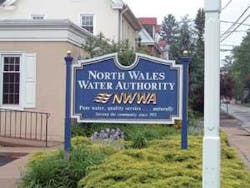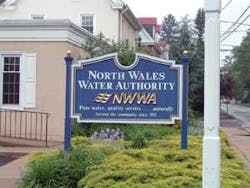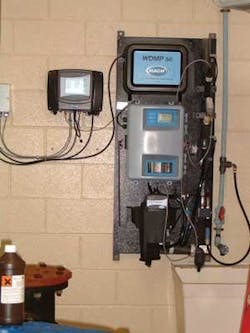Water Authority Ensures System Integrity with Automated Distribution System Monitoring Panels
By Steve Wortendyke
Pennsylvania’s North Wales Water Authority, located 30 miles northwest of Philadelphia, serves more than 25,000 customers in seven municipalities in central Bucks and Montgomery counties. Its transmission and distribution system has more than 30 remote pump stations and water storage tanks located throughout its 399 miles of water pipelines spread over a 50-square-mile service area. The recent addition of multi-parameter water chemistry monitoring panels, installed at various locations within the distribution system, allows the utility to continuously monitor and collect critical water quality data, thereby providing water quality surveillance 24/7.
NWWA, incorporated in 1951, was formed in order to acquire and operate the tiny, privately held North Wales Water Company. In the ‘60s and ‘70s, as more Philadelphians migrated to the suburbs and tapped into existing ground water supplies, NWWA extended its service lines into the surrounding municipalities in order to meet its continuing need for access to public water supplies, acquire a larger service area and develop additional sources of groundwater for its customers’ use. In the early 1990s, NWWA formed a partnership with other utilities to bring in water from the Delaware River located about 30 miles away, which is treated at the authority’s state-of-the-art Forest Park Water Treatment Plant.
Originally completed in 1994, the treatment plant was converted from conventional anthracite/sand media filters to advanced membrane filtration in 2007 to increase capacity and to provide a more effective barrier to potentially harmful pathogens, such as cryptosporidium and giardia. In addition to the robust physical barrier provided by membranes, the plant ozonates to provide a disinfection barrier followed by granular activated carbon (GAC) media filtration to further enhance the aesthetic quality of the water.
Focus On Distribution
Following the plant’s upgrade to membrane filtration, the authority was confident the water leaving the treatment facility was of the highest quality. But the authority then recognized a new concern.
“Once we upgraded our plant we knew it was providing very high quality water,” said Tom Bradbury, Director of Regulatory Affairs at NWWA, “but we then began to turn our attention toward our distribution system. Although the majority of our water mains are fairly new, due to our rapid growth, we became concerned about how to best ensure the quality of our water once it leaves the plant.”
The utility already had a program in place to monitor water quality throughout its distribution system, involving a variety of tasks including scheduled grab sampling and analysis. But in 2006, NWWA decided the best method for assuring water quality delivery was to incorporate automated water quality monitoring systems throughout the water distribution system. These automated systems would continuously monitor and report real-time water quality data to the authority’s water distribution center. In addition, The Homeland Security Act and 9/11 have made it mandatory for water utilities to know at all times what’s going on in their systems. Automated monitoring systems would provide an important key to NWWA’s water security.
After careful research, the authority acquired and installed six Hach Water Distribution Monitoring Panels at strategic points in its distribution system and more panel installations are planned.
Continuous Monitoring
The Water Distribution Monitoring Panel (WDMPsc) is a compact panel fitted with four analyzers to monitor free or total chlorine, turbidity, pH, conductivity, and temperature. A sensor on the panel also monitors water pressure delivered to the analyzers. The installation of each panel required only a single line connection, and one sample port on the panel feeds all of the instruments. The authority’s supervisory control and data acquisition (SCADA) system collects data continuously from the panels, allowing for comprehensive water quality network surveillance at all times.
The utility’s distribution system is divided into five different pressure zones. Along the way, there are a series of inner pressure zone transfer stations, and the water quality monitoring panels have been strategically installed in six of these stations.
The WDMPs are small (22” x 51.5”), lightweight (65 lbs), and include pre-mounted, pre-wired, and pre-plumbed analyzers.
“Our personnel simply mounted each WDMP on a wall and hooked each to an electric line, a water line and an outlet drain,” Bradbury said. “After each panel was installed, baselines for the four water chemistry parameters (chlorine, turbidity, pH, conductivity) were established, allowing us to set the various alarm parameters for each.
“Not all of them are set up the same, due to varying conditions within our system,” he said. “For example, the average chlorine residual might be 0.5 in one part of our system and 0.65 in another.”
The multi-parameter panels allow NWWA to continuously collect critical water quality data, thereby providing surveillance and increased security. The panels continuously transfer real-time data to the authority’s SCADA system, allowing personnel to make informed decisions.
“These monitoring panels are very sensitive,” Bradbury said. “We can tell if somebody has opened a fire hydrant because the turbidity readings will rise. If we get low chlorine or high turbidity or anything out of the ordinary at any station, we’ll get an alarm right away. Four of us can access SCADA from home, so we’re alerted immediately if there’s an alarm.”
Three computer monitors in the authority’s distribution system control room continuously display data. One display is tied into the SCADA system, the second is a backup, and the third shows a script program that brings up critical real-time information on a rotating basis. This setup enables personnel to continually view data from the monitoring panels, check the status of all the pumps in the system, the flow from the plant, storage tank levels, and other critical operations.
“This affords us an instant snapshot of the entire system at any given point in time,” Bradbury said, “and if we need to zero in on any one monitoring panel we can quickly bring it up on our display in the control room for a closer look.”
Continuous, automated monitoring provides much more data than manual testing, enabling a reliable database to be established. The concurrent measurement of several key water chemistry parameters within the system can serve to correlate and confirm a deviation from the normal quality baseline, thereby alert personnel when – or even before – problems occur.
Historical Data
The monitoring panels have helped in certain troubleshooting situations with customers, Bradbury said. For example, a major pharmaceutical company recently reported having a turbidity problem at its facility. Turbidity within the NWWA system typically is about 0.05 NTU, while the pharmaceutical company was reporting readings of up to 3.5 NTU.
“One of our monitoring panels is located just a couple hundred yards from where their supply comes off, so we ran the turbidity history of the panel,” Bradbury said. “We were able to give them a printout of the turbidity data that showed a consistent history of low turbidity.”
After eliminating NWWA water as the source of the problem, further investigation found that a large internal loop going around the complex needed to be flushed.
“Being in the water supply business, you’re always guilty until proven innocent if there’s a problem,” Bradbury said. “That’s another advantage of having those monitors in place. We have an accurate history of all the water that goes through our distribution system.”
Cost, Time Savings
Although NWWA is still required to manually gather and test samples throughout the network for regulatory reporting, Bradbury said that by providing continuous chlorine, turbidity, conductivity, and pH surveillance, the six automated monitoring panels have enabled them to eliminate much of the time-consuming “nuisance sampling.” This has saved miles of driving time for personnel, hours of sampling and testing time, and frees up personnel for performing other important tasks.
The analyzer measurements are also helping NWWA to improve overall water quality through the ability to better identify the potential for chlorine stratification in tanks. Further, the continuous data is allowing personnel to learn more about the unique dynamics of the system.
The authority is currently discussing the installation of additional water monitoring panels to monitor its bulk wholesale water.
“Bringing on our new plant and developing the capacity from the Delaware River gave us an opportunity to not only serve our customers, but also gave us the ability to be a regional water supplier, and we wholesale to four other municipalities. We’re currently discussing adding additional monitoring panels at key sales points to these bulk customers. This will give us a precise water quality history of all flows we deliver to them,” Bradbury said.
About the Author:
Steve Wortendyke is a Sales Development Manager at Hach. During his 11 years of service at Hach, he has also held positions as Regional Sales Manager and Product Manager and was the 2007 Salesman of the Year. Wortendyke received his BS in Chemistry from Oral Roberts University and his MBA for Texas Christian University. Previous to his career at Hach, he spent six years as a Captain in the USAF.


